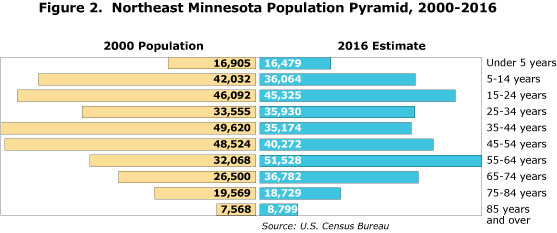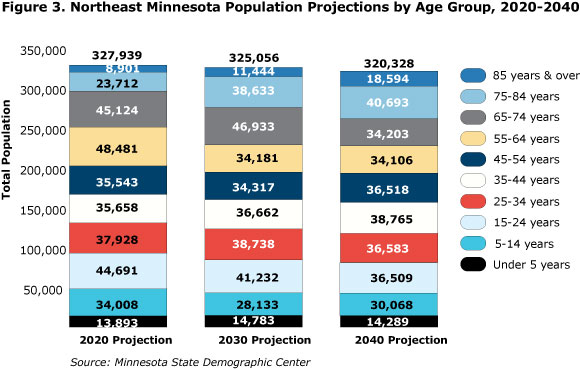
by Erik White
June 2018
The sector is the largest employer in the region and anticipates continued growth as the population ages.
Health care and social assistance is the dominant industry in Northeast Minnesota, though it doesn’t get the headlines of sectors like mining and natural resources or tourism-related leisure and hospitality. The largest employer in the Arrowhead region, the industry continued to gain jobs through the recession and ensuing recovery.
In Northeast Minnesota, 23.9 percent of all covered employment is in health care and social assistance, higher than the 17.1 percent concentration statewide. In fact, Northeast Minnesota has the second-highest concentration of health care and social assistance jobs of the state’s six planning regions, trailing only Southeast Minnesota with its Mayo Clinic facilities in Rochester (see Figure 1).

In 2017, the Northeast Planning Region had 34,121 jobs in health care and social assistance, with an average annual wage of $48,100, which was over $5,000 more than the average annual wage across all industries in the region. Moreover, jobs in the industry have been increasing at a faster rate than the region’s overall economy (see Table 1).
| Table 1. Northeast Minnesota Health Care and Social Assistance Employment Trends | ||||||||
|---|---|---|---|---|---|---|---|---|
| NAICS Code | NAICS Industry Title | 2017 Annual Data | Change in Jobs | |||||
| Number of Firms | Number of Jobs | Average Annual Wages | 2012-2017 | 2007-2017 | ||||
| Numeric | Percent | Numeric | Percent | |||||
| 0 | Total, All Industries | 8,639 | 142,984 | $43,056 | 4,482 | 3.2% | 559 | 0.4% |
| 62 | Health Care and Social Assistance | 927 | 34,121 | $48,100 | 1,551 | 4.8% | 3,261 | 10.6% |
| 621 | Ambulatory Health Care Services | 380 | 5,399 | $74,880 | 488 | 9.9% | -1,432 | -21.0% |
| 622 | Hospitals | 26 | 13,419 | $61,932 | 554 | 4.3% | 2,850 | 27.0% |
| 623 | Nursing and Residential Care Facilities | 287 | 10,745 | $26,520 | 338 | 3.2% | 1,266 | 13.4% |
| 624 | Social Assistance | 235 | 4,558 | $26,468 | 172 | 3.9% | 479 | 11.7% |
| Source: DEED's Quarterly Census of Employment and Wages (QCEW) Program | ||||||||
In the past five years, Northeast has gained 4,482 jobs, a 3.2 percent increase. During that same period, health care and social assistance rose 4.8 percent, adding 1,551 jobs. Over a 10- year span, there was even more pronounced growth, with the industry gaining 3,261 jobs, a remarkable 10.6 percent growth rate. The overall economy during that period barely regained all the jobs that were lost in the 2008 recession. Without these gains, the region's economy would still be climbing out of the recession.
An aging population in Northeast Minnesota will only increase the demand for health care and social assistance services, ensuring future projected growth in this industry. The health care and social assistance industry itself, however, will not be immune to an aging workforce, which will limit the supply of labor. In addition to new jobs being created, the industry will face demands to replace retiring workers. Filling these jobs will be vital to the region's economic stability going forward.
An important factor in the strong concentration of health care and social assistance in Northeast Minnesota is the age of its residents. The Arrowhead region is home to several counties with the oldest population in the state. Aitkin County has a median age of 53.6, and Cook County has a median age of 51.8, the two highest in Minnesota. Even counties with the lowest median age in the region, Carlton and St. Louis, are well above the state as a whole, which in 2016 was 37.8 years old (see Table 2).
| Table 2. Northeast Minnesota's Median Age, 2016 | ||||||||
|---|---|---|---|---|---|---|---|---|
| State of Minnesota | Aitkin County | Carlton County | Cook County | Itasca County | Koochiching County | Lake County | St. Louis County | |
| Median Age (Years) | 37.8 | 53.6 | 41.1 | 51.8 | 45.9 | 48.2 | 50.4 | 41.1 |
| Ranking (of 87 Counties) | - | 87 | 35 | 86 | 71 | 78 | 84 | 37 |
| Source: U.S. Census Bureau's American Community Survey, 2012-2016 5 Year Estimates | ||||||||
The number of people in Northeast Minnesota who were 55 and older increased significantly over the past decade. According to the Census Bureau, 85,705 people were 55 and older in 2000 while 115,838 residents fell into this age cohort in 2016, a 35.2 percent increase. In particular, the number of people 55 to 64 years old now stands at 51,528, a 60.7 percent increase from 2000, representing the tail end of the baby boomers and their march to retirement (see Figure 2).

According to the Minnesota State Demographic Center, the region's population of people 55 and older is projected to reach 130,000 by 2030, driven by an increase in the number in the oldest age cohorts of 75 years and older. This would also suggest an ever-increasing demand for health care support and services in the region.
Meanwhile, the overall population in Northeast Minnesota is expected to decline slightly in the next 20 years. Without population growth, the supply of labor will tighten and make it increasingly difficult to fill the growing number of jobs in health care and social assistance (see Figure 3).

Beyond hiring due to expansion, health care and social assistance will have to replace retiring workers. DEED's new Quarterly Employment Demographics dataset details the age distribution of the workforce in the region by industry. In 2016, 18.5 percent of employees in health care and social assistance were 55 to 64 years old. Another 3.9 percent were 65 years and over. This shows that a substantial amount of the industry's workforce is at or near traditional retirement age.
Breaking down the industry into its subsectors, ambulatory health care services and hospitals stand out, with nearly 25 percent of their workforces already 55 or older and less than 10 percent at age 24 or younger.
Contrast that with nursing and residential care facilities, where 27.5 percent of the workforce is 24 or younger and only 17.6 percent is 55 or older. It makes sense that hospitals and ambulatory health care services wouldn't have a young workforce because the most common jobs – like registered nurses, doctors and surgeons – take years of schooling. Nursing and residential care facilities, meanwhile, rely more heavily on lower-skilled jobs like nursing assistants, personal care aides and home health aides (see Table 3).
| Table 3. Age Distribution of Northeast Minnesota's Health Care Workforce, 2016 | |||||||
|---|---|---|---|---|---|---|---|
| NAICS Code | NAICS Industry Title | Percent 19 and under | Percent 20 to 24 years | Percent 25 to 44 years | Percent 45 to 54 years | Percent 55 to 64 years | Percent 65 years and over |
| 0 | Total, All Industries | 6.5 | 11.6 | 39.6 | 19.8 | 18.0 | 4.5 |
| 62 | Health Care and Social Assistance | 3.4 | 11.4 | 42.7 | 19.9 | 18.5 | 3.9 |
| 621 | Ambulatory Health Care Services | 1.3 | 7.3 | 45.1 | 22.0 | 19.1 | 5.1 |
| 622 | Hospitals | 0.9 | 6.3 | 45.8 | 22.3 | 21.7 | 3.0 |
| 623 | Nursing and Residential Care Facilities | 7.5 | 20.0 | 38.9 | 16.0 | 14.4 | 3.2 |
| 624 | Social Assistance | 3.8 | 11.3 | 40.0 | 19.9 | 18.1 | 6.9 |
| Source: DEED's Quarterly Employment Demographics (QED) | |||||||
Whether from replacement or expansion, there is projected to be plenty of opportunity in health care and social assistance in Northeast Minnesota. Already the largest industry in the region, the sector can expect continued growth because of an aging but stable population. But the aging population also means the supply of labor for those open positions will be constricted. The ability of the industry to overcome this obstacle will influence the region's future economic success and vitality.